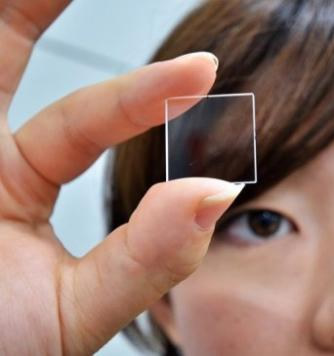This morning Hitachi demonstrated its ability to encode data onto what it calls "quartz glass". Data etched into the material should last 100 million years, the company claims. Diamonds may be forever, but apparently quartz isn't very far behind.
"Quartz glass" is a curious material, being that quartz is actually a trigonal crystal while glass is considered an amorphous solid. Hitatchi's QG formula is likely to remain a secret, but if the mineral is subjected to high enough temperatures for a long enough period of time (at least 2,000 degrees Celsius), it loses its crystalline structure and can be made into a glass-like substance known as fused quartz. This often very pure form of amorphous quartz may be what Hitachi is using.
Writing data to the material is not unlike other optical storage technologies. In Hitachi's demonstration, they used 4 layers of quartz glass. Lasers were then precisely guided to different areas of the substrate to create microscopic pits which may be later read as binary data. By varying laser focal lengths, the recording device could choose which layer to work with.
If the technology has one strength at all, it definitely has to be durability. Although we'll likely never be able to test Hitachi's claim of a 100 million years, the company's research suggests it will last a very, very long time. Accelerated aging tests were performed by exposing the material to blistering temperatures of 1,000 degrees Celsius for two hours; however, the glass remained defiant, failing to exhibit any signs of data degradation.
The prototype storage device is two centimetres (0.8 inches) square and just two millimetres (0.08 inches) thick and made from quartz glass, a highly stable and resilient material, used to make beakers and other instruments for laboratory use. The chip, which is resistant to many chemicals and unaffected by radio waves, can be exposed directly to high temperature flames and heated to 1,000 degrees Celsius (1,832 Fahrenheit) for at least two hours without being damaged. It is also waterproof, meaning it could survive natural calamities, such as fires and tsunami.
Source: phys.org
The new storage medium is expected to hit the market in 2015, but don't expect to replace your SSDs with data crystals any time soon. Although quartz-etched data may essentially last forever, the amount of data it can hold is relatively miniscule. Currently, the process only packs 40MB per square inch – that's roughly equivalent to the density of a compact disc – but falls woefully short of the 1TB per square inch we see on today's magnetic storage devices.
Additionally, there was no mention of the material being erasable or rewritable.
Although the amount of data Hitachi's quartz technology can store is small, this may improve with time. Until then, it could be ideal for recording important works of literature, historical information and such. Just remember though: don't drop it.
